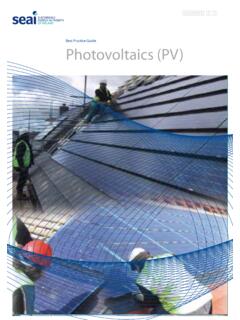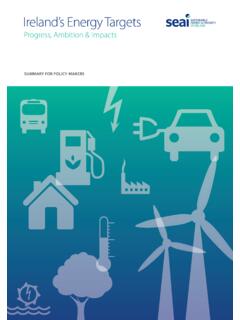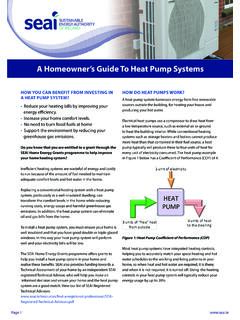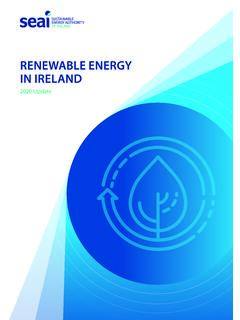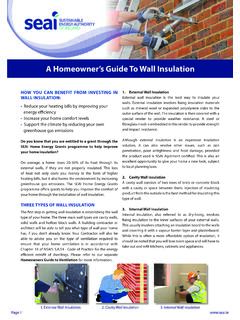Transcription of Code of Practice Solar PV Grant - SEAI
1 DOMESTIC Solar PHOTOVOLTAIC CODE OF Practice FOR INSTALLERS Domestic Solar Photovoltaic Code of Practice for Installers DOMESTIC Solar PHOTOVOLTAIC Code of Practice for Installers February 2022 Sustainable Energy Authority of Ireland SEAI is Ireland s national energy authority investing in, and delivering, appropriate, effective and sustainable solutions to help Ireland s transition to a clean energy future. We work with homeowners, businesses, communities and the Government to achieve this, through expertise, funding, educational programmes, policy advice, research and the development of new technologies.
2 SEAI is funded by the Government of Ireland through the Department of Communications, Climate Action and Environment. Sustainable Energy Authority of Ireland Domestic Solar PV Scheme The Domestic Solar PV Scheme operates under the Microgeneration Support Scheme (MSS) and provides a Grant towards the purchase and installation of a Solar PV system for homeowners. This takes the form of a once-off payment to a homeowner based on the installation of products which meet the requirements of the Scheme. This document describes the requirements that eligible systems under the scheme are required to meet.
3 Version Control Version Number Purpose/Change Page Date Published 15/02/2022 Document changes: In this version the following changes have been made: Updated references to the Microgeneration Support Scheme Changes Domestic Solar Photovoltaic Code of Practice for Installers Contents 1 Definitions .. 1 2 Installer Requirements & Competency .. 2 3 Solar PV System Design 2 4 Component and Installation Requirements .. 3 All Components .. 3 PV Modules .. 3 Mounting 3 Acceptable Forms of Mounting System .. 3 Roof Mounting Systems Loading and Structure .. 4 Roof Mounting Systems Installation.
4 4 Roof Mounting Systems Earthing and Lightning Protection .. 7 Ground and Car-Port Mounting Systems - Installation .. 7 DC Electrical System .. 7 Inverters and Power Converters .. 8 Inverters and Power Converters: .. 8 Inverters and Power Converters - Installation Requirements .. 8 AC Electrical System .. 9 Emergency Isolation .. 9 Distribution System Operator (ESB Networks) .. 10 Off-Grid and Backup Operation .. 11 Energy Storage Systems .. 11 Battery Energy Storage System .. 11 Hot Water Diversion .. 12 Space Heating and Electric Vehicle Diversion .. 13 Inspection, Testing, Commissioning and Handover.
5 13 5 Documentation to be Completed / Provided .. 13 6 Completion Documentation .. 14 7 Annex Labels .. 23 Domestic Solar Photovoltaic Code of Practice for Installers 1 1. 1. Definitions AC Electrical System All AC components connecting the PV inverter (and Battery) to the consumer unit, including cables, isolators, junction boxes, protective devices etc. Battery Energy Storage System (BESS) The system for storing energy from the Solar PV system for later use within the home DC Electrical System All DC components connecting the PV module array to the inverter, including cables, isolators, junction boxes, fuses etc.
6 Homeowner The owner of the home / applicant for Grant . Installer Person who is named on SEAI s Renewable Installers Register under the Solar Photovoltaic category, and SEAI Solar PV Installer Register. Inverter The power converter for converting the energy generated from the Solar PV System into AC electricity for connection to the domestic electrical system. Micro-Inverter Inverter which has one or two Solar PV modules connected to it, typically installed at the back of the Solar PV modules. Module The Solar PV panel including all Solar PV cells, frame, and electrical connections Module Array A collection of multiple Solar PV modules, making up part of the overall PV system.
7 Mounting Bracket The bracket for fixing the Solar PV system to the roof structure. Mounting System The Mounting System includes the mounting frame, connection to the roof (mounting bracket), connection to the ground or building, and connection to the Solar modules. Peak Output - Wp The rated peak power output (DC) of the Solar PV system at Standard Test Conditions. Slate/Tile General term for any pitched roof covering including slates, tiles, bitumen shingles etc. Solar PV Installer Register SEAI maintain a Renewable Installer Register which has a Solar Photovoltaic category. Conditions for registration on this Register can be found at In addition, for the purposes of the Grant scheme, Installers must register for the Solar PV Installer Register.
8 See T&Cs for details. Roof In this document Roof means the roof supporting structure, covering, and all associated roof elements. Programme Microgeneration Support Scheme Scheme SEAI s Domestic Solar PV Scheme Self-consumption The energy generated by the Solar PV system that is used by the homeowner, either directly or indirectly ( , through storage) Solar PV System All components, wiring, electrical interfaces making up the operating Solar PV generator. Standard Test Conditions (STC) Standard Test Conditions in accordance with EN 60904. Storage Refers to energy storage of all types thermal, battery etc.
9 String Inverter Inverter which has a string or strings of one or more Solar PV modules connected to it, typically installed inside the home Table 1 Domestic Solar Photovoltaic Code of Practice for Installers 2. 2. Installer Requirements & Competency For the purposes of the Scheme all elements of a Solar PV system must be compliant with all applicable Irish legislation, building regulations, and applicable guidance, which may or may not be included in this Code of Practice . The Installer has total responsibility for ensuring compliance and must obtain assistance where required.
10 The Installer must be registered on SEAI s Solar PV Installer Register at the time the installation is carried out. The Installer must satisfy themselves, and certify, that the Solar PV system installation has been designed, installed, tested, and commissioned in accordance with this code of Practice , and other relevant codes, standards and building regulations. The Installer must, at his/her cost, provide all information required by SEAI or SEAI s agents for the purposes of audit and inspection. Any queries on this code of Practice can be sent to 3. Solar PV System Design Requirements The Installer must use due care and attention to design a suitable, and optimum, Solar PV system (and storage system, if included) for the homeowner, considering.
